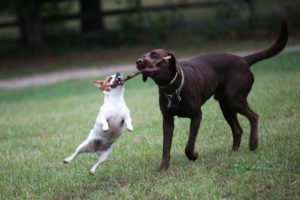 “Think Big!” by drphotomoto on Flickr
“Think Big!” by drphotomoto on Flickr
In an earlier post, I designed a simple RPG in which players can choose an Easy roll for a good chance at success, or a Hard roll for a low chance plus a coupon for automatic success later.
But success and failure are boring.
Let’s re-think success and failure in the context of a tabletop RPG. Success makes intuitive sense: getting what you want. Failure often feels like simply not getting what you want. Failure can be interesting, but we often have to force ourselves to make that failure interesting.
Let’s avoid those terms, and use more exciting ones: winning and losing. That may sound the same, but bear with me. Thanks to our social exposure to sports, losing sounds less dramatic and more temporary than failing. You can lose one game in a season and it won’t kill your chances at the championship.
So, you can win or lose your die roll. Winning makes sense. But what does losing mean? We know what that means in sports: a setback. If a team loses a game, they have a harder time getting to the championship.
As a result, in this game, losing a roll results in getting further into trouble.
Let’s fold that into our rules:
- Creating Interesting Characters: Describe your character as specifically as possible. Describe activities that are effortless for your character, and those that are troublesome for the character. You do not need to stat your character, but you’ll want to be clear to the other players. If playing with a GM, the GM has final say over this.
- When Things Get Dicey: Any time you want to get something for your character, succeed at a task, win a contest with another character, etc.: roll a six-sided die. 1. Difficulty: You can make the roll Easy or Hard. 1. You win an Easy roll if you roll a 2 or higher.
- You win a Hard roll if you roll 5 or 6. Just for attempting a Hard roll, you get a Plot Point (no matter what you roll).
- What Happens:1. If you win your roll, you get what you want (the item, the completion of the task, overcoming your opponent).
- If you lose your roll, you make some progress but don’t get what you want immediately, and you go deeper into trouble. The GM or the rest of the group can define the trouble.
- Getting In Trouble: If playing with a GM, the GM can declare a task Troublesome for you. If playing without a GM, the group can declare a task Troublesome. This usually happens when a character attempts a task particularly unfit for that character (a weak character attempting to arm-wrestle a hulk). 1. When rolling a Troublesome task, roll 2 dice and use the lowest number rolled.
- Plot Points: You can trade in a Plot Point to bypass a die roll and automatically get what you want without trouble, or to narrate your own trouble if you lose on your die roll. You can’t use a Plot Point earned for a roll to affect that roll.
Thoughts?
(This system is still released under a CC-BY-3.0 license, so expand and play with it as you wish.)
![[Atom feed]](/user/themes/geek-archaeology/images/atom-feed.png)
![[RSS feed]](/user/themes/geek-archaeology/images/rss-feed.png)
![[iTunes podcast feed]](/user/themes/geek-archaeology/images/itunes-feed.png)